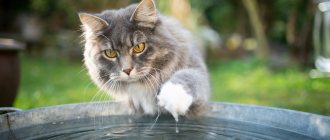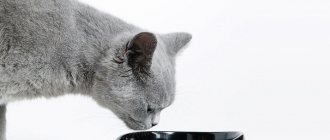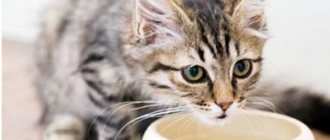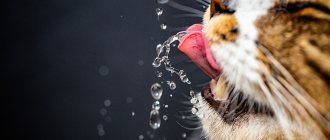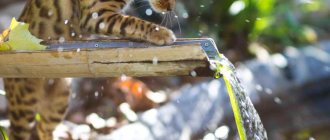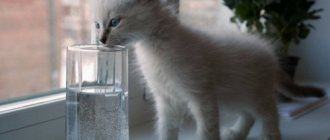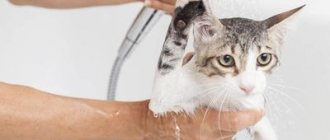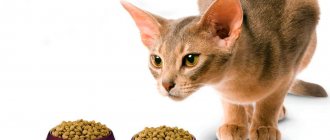A cat's body is 65% fluid. A pet's diet must include not only tasty and high-quality food, but also clean drinking water, which is of great importance for the body. Water takes part in many important life processes and helps dissolve substances entering the digestive tract.
In this article we will look at how to properly give a cat water, how much liquid a cat should be given per day, how to prepare water for drinking, methods for accustoming a cat to water, and answers to popular questions.
How much water should a cat drink per day?
Cats do not need a lot of liquid, but your pet's daily diet must include clean water. Broths and other liquid formulations cannot fully replace regular drinking water. The average daily water intake for a cat is 40-50 ml of liquid per 1 kg of weight.
If a cat eats wet food and eats other nutritious foods well, a certain portion of its daily fluid intake will enter its body. She gets the rest with drinking water. This is why the owner often thinks that the cat does not drink water at all or drinks very little.
Other reasons
However, it also happens that none of the listed reasons are suitable. Then the owners do not understand why the cat drinks a lot of water, what it means and how to treat it. Among these reasons are:
- increased sweating;
- taking special medications (diuretics, corticosteroids, sometimes due to side effects of sedatives or painkillers);
- loose stools;
- discharge from the genitals;
- dropsy (a disease characterized by the accumulation of fluid in the cavities and tissues of the body);
- stress and mental disorders;
- brain pathologies.
If you notice that your pet is drinking much more water than usual, you should first conduct a home examination, and then (if there is no harmless explanation) contact your veterinarian!
What kind of water to give your cat
The health and life expectancy of a cat largely depends on the quality of drinking water. The best option for an animal is soft natural water from drinking sources. This water contains beneficial microelements for the body.
Alternatively, you can give your cat filtered or frozen water. Do not give your domestic cat water from the tap. As a rule, it is not of good quality. In addition, it may contain impurities that are dangerous to the cat’s body.
Preparation
The cat is given drinking water in a clean ceramic or glass bowl. The container must be washed daily.
Temperature
Do not give your pet too cold or hot water. The liquid should be at room temperature.
Supplements
Some owners add various additives to their cat’s water to improve the taste or quality of the drinking composition.
Water additives:
- fluorine, iodine (quality improves);
- tuna juice, anchovies (cats are attracted by the smell);
- nettle infusion (for medicinal purposes);
- special nutritional drink for cats.
Why is water so important to animals?
Despite the fact that up to 70% of a mammal's body consists of water, it constantly needs to be replenished from the outside. It is found in the blood, muscles, bones and is involved in the most important internal processes:
- delivers oxygen to cells;
- maintains a constant body temperature;
- lubricates joint tissues and mucous membranes;
- dissolves nutrients, facilitating the digestion and absorption of food;
- removes toxins from the body that accumulate in waste products;
- humidifies the air in the lungs.
Prolonged lack of moisture leads to a reduction in urination and increased urine concentration. This is fraught with the development of urolithiasis, cystitis and kidney pathologies. If you do not give your pet the recommended amount of fluid, he may get sick or die from dehydration.
Answers on questions
Each cat is individual. Some simply drink water without creating any problems for the owner, while other representatives of the feline family are afraid of any liquid and categorically refuse to put their muzzle in a bowl so as not to wet their whiskers.
We have prepared answers to the most common questions that owners of pet cats and cats have.
The cat does not drink water: what to do
A cat's reluctance to drink water may alert the owner.
Insufficient fluid intake leads to dehydration of the body, disrupts the biochemical parameters of the blood, which in turn provokes the development of severe liver and kidney diseases. Before taking measures to correct this situation, you need to determine the reason for the cat’s refusal to drink fluids. Reasons why a cat does not drink water:
- The cat eats wet food. They contain up to 80% liquid, which is quite enough for the animal’s body.
- Reluctance to drink from an uncomfortable bowl. You can try changing the water tank to another one with wider edges, so that it is more convenient for the cat to lap up the water.
- Stale or poor quality water. Cats are very finicky and may refuse to take liquid if it does not meet their needs.
- Serious illness. As a rule, in such cases, the cat refuses not only water, but also food, or consumes it in smaller quantities, without showing much appetite. In this case, the animal needs to be shown to a veterinarian.
Try to find out the reason for the cat's refusal of water. Observe her and if you see that she drinks water from other sources, but categorically refuses to lap up the liquid from her bowl, try replacing it or placing it away from the food bowl. Some cats generally do not drink water if it is next to food.
Special additives that improve the taste and quality of the liquid will also help to accustom your cat to water. Some breeders add a pinch of soda to drinking water or throw an ice cube into a bowl of water. Cats are very curious and may become interested in water if something foreign is floating in it.
If your cat is often outside, there is a high chance that she is getting the amount of fluid she needs from outside sources. These could be ordinary puddles, which, of course, is very unsafe. In this case, the animal can only be retrained by limiting its access to the street for independent walks.
Is it normal for a cat to drink a lot of water?
Excessive water consumption is a clear sign of extreme thirst, which may indicate the development of certain diseases in the cat's body. This symptom is typical for hormonal disorders, diabetes, kidney disease, infectious diseases and febrile conditions.
If your cat drinks a lot of water and there are additional signs of her unhealthy condition, you should immediately take her to a veterinarian, who can determine the exact problem of her unhealthy interest in drinking liquids.
There is no need to worry if a cat that regularly eats dry food drinks a lot of water. With such a diet, the animal must consume a sufficient amount of liquid per day.
Can cats drink sea and salt water?
Cats located far from fresh water can quench their thirst with sea water. Their body filters salt well and removes the unnecessary element naturally. There will be no harm to your cat after drinking salt water, but you should not give it to your cat for daily drinking.
Should I give my cat mineral water?
There are times when a cat accidentally drinks mineral water from its owner’s mug and shows with all its appearance that it quite liked this liquid. Should you give your cat mineral water? Absolutely not, only in the absence of fresh water or for medicinal purposes, as prescribed by a veterinarian. If you regularly give your cat mineral water, urolithiasis may develop.
Should you give your cat boiled water?
Boiled water has a specific taste and, as a rule, cats do not particularly like it. In addition, it is completely useless for the body, so it is not recommended to give such water to a domestic cat. It is better to choose filtered, frozen or bottled water for drinking your pet.
Why does a cat move or overturn the bowl and spill water?
The cat spills water, moves the bowl - what to do? Many animals simply play with water, trying to entertain themselves with something. The reason for this behavior may also be the proximity of the food bowl. Try moving the water container to a different location.
And with this behavior, a cat may indicate the need to change stagnant water to clean and fresh. Change the fluid, not forgetting to rinse the reservoir itself thoroughly.
Watch your cat and learn to recognize her desires! Don't ignore the problem of water refusal or excessive thirst. In any unclear situation, contact your veterinarian.
Water bowls should be everywhere
Cats are quite capricious animals, many of them are convinced that the whole world revolves around them. They decide for themselves where to sleep, where to play and where to drink water. Therefore, when answering the question of how to get a cat to drink water, many make a knight’s move and place containers of water in different places.
Soon the animal will independently determine in what place it will be convenient for him to drink water. Perhaps in this simple way you will be able to solve the age-old problem of how to teach a cat to drink water.
Research by scientists
One day, a fellow at the Massachusetts Institute of Technology, Roman Stoker, was watching his kitty, Guta-Guta, lapping up milk. The scientist was fascinated by the slight movements of his pet and decided with his colleagues to carefully study this issue.
The results of the study were astounding
It turned out that the cat was drinking using the tip of its tongue as a spoon. Its speed is approximately a meter per second.
When a cat quickly bends its tongue, the liquid collects in a column, the height of which grows by inertia. The mustache then closes its mouth to take a sip before gravity destroys the column of water.
Curiously, large purrs lap more slowly. It is not yet known what causes this paradox.
Cats drink more carefully than dogs
A cat's lapping technique is different from a dog's. The dogs grab the water with their tongues and fill their cheeks with it. Unlike his furry friend, the fluffy one does not splash the water. His face remains dry.
Why does a cat drink a lot?
The reasons why a cat consumes an increased amount of fluid can be divided into physiological and pathological.
The first group includes the following factors not related to organ pathology:
- Pregnancy, lactation period.
- Recovery period after surgery.
- Excessive physical activity.
- Hot weather.
- High salt content or insufficient protein in the diet.
- The use of certain foods, such as rice, which acts in animals in much the same way as the diuretic furosemide.
- Dry food. Manufacturers also do not recommend changing food unless necessary.
- Dry indoor air.
- Dampness.
- Elderly age. Kittens, as a rule, drink little, but polydipsia is often observed in older animals.
These reasons do not pose a risk to the cat's health. As soon as her condition is restored or the factors are eliminated, thirst will disappear.
Pathological reasons that force an animal to drink a lot include:
- diabetes;
- chronic renal failure;
- viral and inflammatory diseases;
- pyelonephritis;
- insulinoma;
- hyperthyroidism;
- malignant and benign liver tumors;
- hepatitis.
It is not uncommon for a cat to experience abnormal fluid intake due to stress. A change of place of residence, the appearance of another pet in the house, noisy company, or a long absence of owners can contribute to the symptom of polydipsia.
Finally, another reason why an animal constantly drinks water is taking certain medications.
Drugs that cause increased thirst include corticosteroids, diuretics, sedatives, in particular Xylazine.
A thirsty cat should never be limited in water. An animal deprived of the opportunity to drink may die. There should always be enough water in the bowl; it should be changed daily, and in hot weather - 2-3 times a day.
You should not give raw tap or distilled water to animals; boiled or filtered water is much safer for them. The animal should not be allowed to drink water from the aquarium, much less from the toilet.
Lapping mechanism
The question of exactly how cats drink has worried scientists for a long time, and in the 40s of the last century, Professor G. Edgerton from the Massachusetts Institute of Technology used stroboscopic photography to reveal the mechanism of cat lapping.
Work on studying how a cat drinks has been continued in our time with the help of high-speed photography. This slow-motion video clearly shows how a cat laps milk and exactly what movements the cat's tongue makes.
However, Edgerton's conclusions that cats use their tongues as a kind of inverted spoon when lapping turned out to be not entirely correct. A number of scientists from various scientific institutions, including the same Massachusetts Institute of Technology, have proven that it’s all about adhesion (sticking of liquid to the tongue) and high speed of movements.
They can't chew food
Don't be discouraged when you see a lot of food scraps scattered around where your cat is eating. Your pet simply does not know how to chew food. Its fangs are used to tear or cut food into smaller pieces before swallowing it. In the same way, when a cat eats dry food, it splits it into smaller pieces, causing some of the food to fall out of its mouth. This is a completely natural process!
Found a violation? Report content
Fermented milk products for cats
Fermented milk products are an excellent aid for raising kittens. So, cottage cheese is very useful: it contains protein, calcium, and all the beneficial substances inherent in milk. Sour cream is an excellent treat, no less healthy and nutritious than cottage cheese.
Sour cream is a great treat for cats, but you shouldn’t overuse it.
It’s more difficult with kefir. The older the drink, the higher the ethanol content (in young kefir - 0.2-0.6%, in 3-4 days old - up to 2%). This is the natural formation of alcohol during the ripening process of kefir. But its benefits for the cat’s small and delicate body are very doubtful. Young kefir (not older than two days) – weakens. Therefore, if your cat suffers from constipation, you can offer this product. A ripe drink (more than two days), on the contrary, strengthens it. So sudden diarrhea can be stopped with mature kefir. True, it is too sour, and not all cats will accept the treat.
As for cheeses, they are all too fatty for a cat’s stomach (up to 55% fat content). They shouldn't be given. Of course, if the cat is an ardent fan of cheese, then you can select a couple of small pieces. But then you need to choose the least fatty varieties (Tofu - up to 4%, Mozzarella - up to 15%, Gaudette - up to 12%).
Only those dairy products that contain regular sugar are strictly prohibited: cheese curds, curds, yoghurts (except natural ones) and other artificially sweetened fermented milk products. While a cat’s body can cope with lactose, sucrose is an indigestible substance for a cat.
Approximate fat content of fermented milk products:
- cottage cheese - up to 9%;
- curdled milk, kefir, fermented baked milk, natural yogurt - up to 3.5%;
- sour cream - from 10%, to feed your pet it must be diluted (1/1) with warm water.
Based on these data, you can safely offer your pet fermented milk products, but not more than 2 times a week.
How can you replace milk in a cat's diet?
If your pet suffers from milk intolerance or is allergic, but you don’t want to deprive him of a “milk treat,” then the following will come to the rescue:
- fermented milk products;
- milk formula for baby food is a breast milk substitute product for children; it can be given in small quantities to cats, diluted with a little more water than indicated in the instructions (for kittens - 2 times more);
- a special lactose-free dairy product, intended for cats that love milk very much, taking into account the peculiarities of their digestion (the pet is given up to 60 ml per day);
Moderation in food is the key to a pet’s health and long life. Milk will always be a topic of controversy. You should not deprive your cat of this product if it tolerates milk protein and lactose well. It is enough to observe the measure.
The filming revealed the secret of lapping
To explain the nature of lapping, specialist Harold Edgerton from the Massachusetts Institute of Technology conducted an experiment in 1940 in which he used stroboscopic photography. At the same time, it was proven that when an animal laps, it first touches the surface of the water with the upper part of its tongue.
Cats are a unique creation of nature. Flexible, agile, dexterous. Even a drinking cat looks graceful, barely touching the water with its tongue. Not only domestic but also wild representatives of the cat family drink in such an original way: lions, tigers, leopards, panthers. How do cats do this?
The filming revealed the secret of lapping
To explain the nature of lapping, specialist Harold Edgerton from the Massachusetts Institute of Technology conducted an experiment in 1940 in which he used stroboscopic photography. At the same time, it was proven that when an animal laps, it first touches the surface of the water with the upper part of its tongue.
Almost half a century later, the experiment was repeated again. This time the filming was carried out by Roman Stoker, who clarified that the cat's tongue almost does not penetrate deeper than the surface of the liquid. The specialist carried out the experiment by observing his own cat. He had a high-speed camera at the ready. The filming allowed us to analyze the lapping process and draw appropriate conclusions.
When an animal touches the surface of a liquid, a certain part of it, due to the property of adhesion, “sticks” to the cat’s tongue. The column of water that forms between the cat's mouth and the surface of the liquid constantly changes its thickness and height. The nature of cats is such that they instinctively feel at what moment the column of liquid is at its largest. At this time, the animal quickly closes its mouth, as if “biting off” the upper part of the water column.

